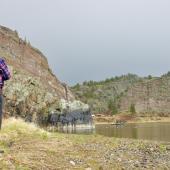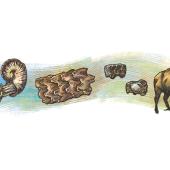Wild West Words: Spring 2016
RODEO (and other Spanish Legacies) & DOGIE
Though rodeo and its typical style of horsemanship is unique to western North America, many of its customs reflect an Old World Spanish heritage. The traditional cowboy skills of bronc and bull riding, calf roping, and steer wrestling can be traced to the Spaniards who brought their horses and cattle to the New World in the 16th and 17th centuries.
As Spanish culture expanded throughout Mexico and into the American Southwest, its customs of horse and cattle management were adopted and adapted by indigenous people and settlers of all stripes. Spanish, the language of horsemanship and its accoutrements, accompanied the expansion.

The term rodeo comes from the Spanish verb rodear, “go around, surround.” Before rodeo was a public demonstration of cowboy skills, as it is today, it signified a time and place for the impoundment — the “surrounding” — of cattle. In 1830, British adventurer to Venezuela Richard L. Vowell recorded this observation in his journal:
In Autumn, the rodeo takes place... This word literally signifies, the surrounding, and implies the operation of collecting and driving together all the cattle of the estancia for the purpose of taking account of them, and branding such as have not yet received the proprietor’s mark.
The season of driving the cattle into the rodeo gradually became the English round-up, when cattle are surrounded to be branded, separated, and doctored. Novelist Thomas M. Reid, traveling through Mexico in 1847, noted this of a Southwestern cattle outfit:
“At this time of year the cowmen have what is called the round up, when the calves are branded and the fat beasts selected.”
By the 1880s, cowboys in the frontier towns of Pecos, Texas and Peyson, Arizona, were roping cattle and riding broncs for bragging rights. These early contests of equestrian skill, held publicly, were the precursors of the modern North American rodeo. The American participants adopted the Spanish name for it by at least 1884.
Spanish has left its linguistic footprints across the American West. The untamed horses ridden in rodeo contests are broncs. The word derives from a Spanish adjective bronco, “rough, rude.” This, in turn comes from a noun meaning “a knot in wood,” a thing requiring planing to render it smooth, just as a bronc is tamed and ridden into compliance.
The small, tough, rangy mustangs, mixed-breed descendants of the original Spanish horses, got their Anglicized name from mestengo, “animal that strays.” A halter with reins and a noseband instead of a bit is a hackamore, the English version of the Spanish jaquima (“headstall”).
Chaparral, the name for dense thickets of evergreen shrubs, is a loan word from the Spanish chaparro, a species of oak native to Spain. The cowboy’s armor against the thorny American plant was originally chaparreras, “protection from chaparral.” Chaps still protect Western riders from rough vegetation, barbed wire, and fence scrapes.
DOGIE
In the traditional western ballad “Git Along Little Dogies” the cowboy sings, “whoopee ti yi yo, git along little dogies, it’s your misfortune and none of my own, whoopee ti yi yo, git along little dogies, you know that Wyomin’ will be your new home.”
The “dogie” immortalized in this song is an undersized orphaned calf, whom cowboys claim had lost its mammy and whose daddy run off with another cow. The origin of this moniker has been lost, but several theories have arisen to explain it.
Some sources claim it comes from the Afro-Creole term dogi meaning “small” or “short,” in reference to the stunted stature of orphaned calves. In another speculation, the malnourished calves being barely larger than dogs inspired cowboys to call them doggies or dogies, again in reference to their diminutive size.
The most plausible explanation is given by Ramon Adams, editor of the cowboy dictionary Western Words. He tells us the motherless calves, forced to eat grass before they could efficiently digest it, developed distended, bloated bellies. To the cow man, it looked as though these orphans had a belly full of sour dough. The calves were called dough-guts, which later became doughies or dogies.












Leave a Comment Here